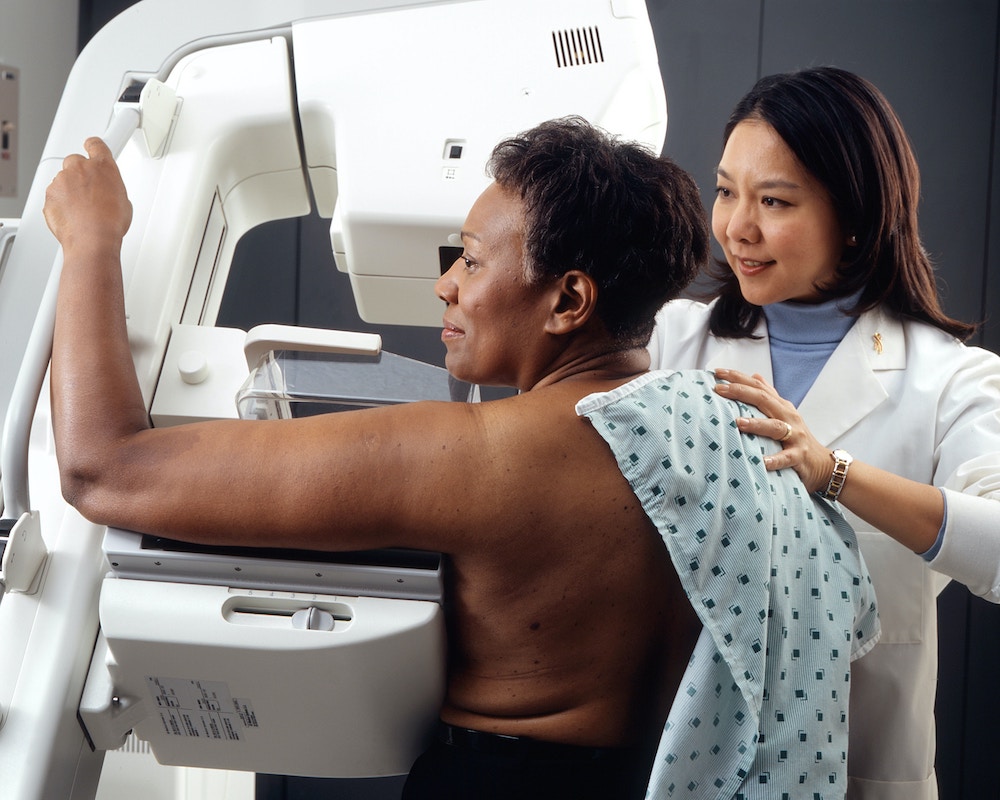Firstly, we want to congratulate you on doing the necessary research to be ready for your mammogram! Yes, getting a mammogram for the first time is intimidating, but if you’ve successfully scheduled and overcome a pap smear, you are capable of anything.
Mammograms are used to detect early signs of breast cancer. Breast cancer is most treatable in its early stages, which is why preventative checks are so crucial for women. Mammograms are similar to getting an X-ray of your breast tissue. They allow doctors to physically see inside breasts to check out what, exactly, is happening in there. They’re especially useful because they really give the doctor everything they need to know – these days, mammograms capture even the most minute details, so they’re highly effective. Trust us, scheduling a mammogram is worth every woman’s time.
So, what’s the difference between a mammogram and an ultrasound?
An ultrasound uses high-frequency sound waves that bounce off the tissues within our bodies, which a computer then converts to an image.
A mammogram, on the other hand, is a low-dose version of an X-ray, which is why metal plates are needed during the procedure. The electrodes released during the mammogram have to bounce off the surrounding metal to capture the image of the mammogram, showing healthcare providers any breast cancer or other breast diseases present. Sometimes, both mammograms and ultrasounds are used in tandem to help the doctor understand what is going on within the breast.
Ultrasounds are not a replacement for mammograms of breast cancer, but aid doctors in checking any abnormal areas found in patients with mammograms of dense breast tissue. They are used in addition to a mammogram, but never replace one entirely!
Nowadays, doctors will decide to administer one of three types of mammograms: film-screen mammography, digital mammography in 2D, and digital mammography in 3D.
What is digital mammography in 2D?
This practice takes two images of each breast and uses them to create a 2D image of each. It was standard practice until 2011.
What is digital mammography in 3D?
Also known as digital breast tomosynthesis, digital tomosynthesis, or just tomosynthesis, 3D digital mammography uses several images of each breast to create a detailed 3D image of the breast. This has become standard care for breast cancer after gaining approval from the FDA in 2011. Studies show that 3D digital mammography finds more cancers than the traditional 2D method and gives fewer false positives.
What is film-screen mammography?
This type of mammogram produces black-and-white images on film, takes a little more time to create, and was more commonly administered in the past.

What’s the age of the first mammogram in the U.S.?
The United States Preventative Services Taskforce recommends that women begin to regularly schedule screening mammograms at the age of 40. After, mammograms should be scheduled every one to two years for a breast check-up if there are no symptoms found.
When should I begin self-examining my breasts?
This is another crucial preventative step! And it’s a quick and simple process. Young women should begin self-examining their breasts as soon as they mature and their breasts stop growing, or around the age of 20. Read through this helpful guide on how to self-examine your breasts.
When women examine their breasts regularly beginning at a young age, they are more likely to discover any irregularities or changes before they develop into something more serious. Self-examination is another fantastic preventative practice all young women should include in their weekly schedules.
Waiting until the week after your period to conduct self-examinations is recommended to avoid any pain or abnormalities caused by hormone fluctuations and swelling.
When self-examining breasts, always look out for:
- Lumps that are new, growing, or changing shape.
- Swelling or thickening of a certain area or part of the breast or armpit.
- Nipple abnormalities like reddening, flaking, pulling in, or discharge.
- Pain that is sudden, irregular, or creates constant discomfort.
- Changes in size that are sudden or seem out-of-the-blue, unrelated to hormonal fluctuations or periods.
If you discover any of these symptoms of breast cancer, reach out to your doctor or schedule a diagnostic mammogram with a doctor near you to check your breasts as soon as possible.
Take a closer look at mammogram screening guidelines.
So, whether it’s your first time getting a mammogram at age 40 or taking preventative steps and scheduling a diagnostic mammogram early,:
 Here’s Our Step-by-Step Guide to Your First Mammogram
Here’s Our Step-by-Step Guide to Your First Mammogram
Schedule a Mammogram Appointment:
- Ask your doctor or do some research to find a reputable mammography facility or clinic in your area.
- Call or register online to schedule an appointment.
- Make sure they specialize in mammograms and have qualified radiologists!
Timing:
- Avoid scheduling the appointment during the week before your period when your breasts may be more sensitive. Although mammograms are not invasive, pressure is applied to the breast which can create discomfort.
Clothing and Comfort:
- We recommend wearing a two-piece outfit, as you’ll need to undress from the waist up.
- Avoid wearing deodorant, lotions, or powders on your upper body, as they can interfere with the imaging.
Communicate and Share:
- Sharing your medical history, prior surgeries, or family history of breast cancer can help doctors provide the best care.
- Always inform the technician if you have breast implants or have had any breast-related procedures or concerns.
How long do mammograms take?
- Roughly 20 minutes!
- You’ll be asked to undress from the waist up and will be given a gown to wear during the procedure.
The Procedure:
- First, the technician will position your breast between two metal plates on the mammography machine.
- Then, the plates will compress your breast for a few seconds to get the clearest images. While it may feel uncomfortable or slightly painful, it shouldn’t be overly painful. Communicate any discomfort you feel to the technician.
- Because mammograms usually involve two images of each breast taken from different angles, the technician may reposition your breast between images.
After the Procedure:
- Once the images are taken, you’ll be asked to wait while the technician ensures the images they captured are high-quality.
- Once the quality of the images is confirmed, you can get dressed.
Some women may experience mild bruising or temporary discomfort. This should subside quickly.
How long does it take to get mammogram test results?
- You’ll receive your results within a few weeks after your radiologist interprets your mammogram and sends the results to your healthcare provider.
Don’t panic if you’re called back for additional tests, as most callbacks do not indicate breast cancer.
What to Do Before and After a Mammogram:
- Stay relaxed and take deep breaths before the procedure – always communicate discomfort and pain to your doctor!
- Follow all instructions given to you by the mammography facility.
- Afterward, continue to schedule regular mammogram screenings as recommended by your healthcare provider.
- Know your mammogram schedule and never skip routine screenings.
What Not to Do Before and After a Mammogram:
- Don’t wear metallic accessories or clothing items, as they interfere with the mammogram images.
- Try not to schedule your mammogram at a time when your breasts are likely to be sore or swollen to avoid discomfort.
- Don’t be afraid to ask questions and voice any concerns to your technician or radiologist.
We hope this guide on how to prepare for your first mammogram helps; that’s what we’re here for! At Pawsitively 4 Pink, our passion is providing direct financial support for local, underserved women fighting breast cancer. Please contact us to find out more about ways to help, or donate directly.

